Architectural Anatomy and Application in an Ultra-Low-Permeability Reservoir: A Case Study from the Huang 57 Area, Jiyuan Oilfield
Abstract
1. Introduction
2. Geological Setting
3. Materials and Methods
3.1. Sedimentary Facies and Reservoir Architecture
3.1.1. Types of Sedimentary Microfacies
- (1)
- Subaqueous distributary channel
- (2)
- Sheet sand
- (3)
- Lacustrine mud
3.1.2. Sandbody Distribution Characteristics
3.1.3. Reservoir Architecture Recognition Criteria
- (1)
- Lateral Variation in Sedimentary Facies
- (2)
- Elevation Difference in Sandbody Top
- (3)
- Sandbody Thickness Variation
- (4)
- Log Curve Morphology Variations
- (5)
- Difference in Hydrocarbon Potential
3.1.4. Data Processing Hardware and Software
3.2. Reservoir Architectural Analysis Results
3.2.1. Architectural Interpretation Validation
3.2.2. Reservoir Architecture Model
- (1)
- Laterally Detached
- (2)
- Vertically Disconnected
- (3)
- Vertical Stacking of Channels
- (4)
- Vertical Stacking of Channel and Sheet Sand
- (5)
- Lateral Splice of Channels
- (6)
- Lateral Connection of Channel and Sheet Sand
4. Result
5. Discussion
6. Conclusions
- (1)
- Five logging identification criteria for architectural boundaries of subaqueous distributary channels were established, including lateral variation in sedimentary facies, elevation differences in sandbody tops, abrupt thickness changes, variations in log curve morphology, and differences in hydrocarbon potential, enabling quantitative identification of single-channel boundaries.
- (2)
- Two genetic architectural patterns—isolated and amalgamated—were identified in the study area, which can be further subdivided into four distinct stacking styles. Among these, the lateral connection of channel and sheet sand is the predominant configuration.
- (3)
- Architectural heterogeneity controls the distribution of remaining oil, which is primarily enriched along channel margins, near architectural boundaries, and in unswept areas with poor injection–production connectivity.
- (4)
- Dynamic production responses (e.g., changes in fluid production after fracturing in Well Y88-45 and water breakthrough patterns in Well Y89-44) effectively validated the reliability of the architectural classification, indicating that architectural interfaces are key barriers influencing fluid flow.
Author Contributions
Funding
Data Availability Statement
Conflicts of Interest
References
- Zou, C.; Zhao, W.; Zhang, X.; Luo, P.; Wang, L.; Liu, L.; Xue, S.; Yuan, X.; Zhu, R.; Tao, S. Formation and Distribution of Shalow-water Deltas and Centra-basin Sandbodies in Large Open Depression Lake Basins. Acta Geol. Sin. 2008, 28, 813–825. [Google Scholar]
- Wang, C.; Dan, W.; Fang, Y.; Zhang, Z. Sedimentary characteristics and geological significance of shallow water delta of Chang8 oil formation in Ordos Basin. J. Oil Gas Technol. 2013, 35, 12–15. [Google Scholar]
- Guo, Y.; Li, B.; Li, B.; Li, W.; Cao, H.; Liao, Y.; Wu, Z.; Fei, S.; Zhang, Q.; Chen, Q. Sedimentary system and palaeogeographic evolution of ordos basin, northern china. J. Palaeogeogr. (Chin. Ed.) 2025, 14, 501–534. [Google Scholar] [CrossRef]
- Wang, J.; Wang, L.; Yin, Y.; Xie, P.; Xiong, G. Comprehensive Reservoir Architecture Dissection and Microfacies Analysis of the Chang 8 Oil Group in the Luo 1 Well Area, Jiyuan Oilfield. Appl. Sci. 2025, 15, 1082. [Google Scholar] [CrossRef]
- Liu, G.; Gao, W.; Zhang, D.; Chen, L.; Li, A. Sandbody structure and its genesis of shallow-water delta of Chang 8, reservoir in Jiyuan area, Ordos Basin. Lithol. Reserv. 2019, 31, 16–23. [Google Scholar]
- Li, Y.; Liu, C.; Du, Y.; Wang, X.; Huang, J. Sedimentary characteristics of shallow water delta and lake shoreline control on sandbodies of Chang 8 oil-bearing in tervalof the Upper Triassic Yanchang Fomation in northwestern Ordos Basin. J. Palaeogeogr. (Chin. Ed.) 2009, 11, 265–274. [Google Scholar]
- Liu, Z.; Li, X.; Zheng, R.; Liu, H.; Yang, Z. Sedimentary characteristics and models of shallow water delta front subfacies reservoirs: A case study of Sapugao oil layer in north-II block of Sabei oilfield, Daging placanticline. Lithol. Reserv. 2022, 34, 1–13. [Google Scholar]
- Zhou, X.; Liu, L.; Wang, J.; Dai, J.; Lan, C. Storm deposits in wide and shallow lacustrine environment in Yanchang Formation, Ordos Basin. Sci. Technol. Rev. 2016, 34, 203–208. [Google Scholar]
- Fu, C. Depositional architecture of aggrading delta front distributary channels and corresponding depositional evolution process in ordos basin: Implications for deltaic reservoir prediction. Water 2025, 17, 528. [Google Scholar] [CrossRef]
- Zhang, Y.; Bao, Z.; Dou, L.; Jiang, L.; Zhang, L. Hydrodynamics and deposition in lacustrine shallow-water delta front: A combination of numerical simulations and modern sedimentation measurements. Interpretation 2020, 8, SM39–SM52. [Google Scholar] [CrossRef]
- Chen, Z.; Zhang, J.; Yong, Z.; Ma, H. Tight Sandstone Reservoir Characteristics and Sand Body Distribution of the Eighth Member of Permian Shihezi Formation in the Longdong Area, Ordos Basin. Minerals 2025, 15, 463. [Google Scholar] [CrossRef]
- Liao, J.; Hong, L.; Li, Z.; Tan, K.; Zhao, L.; Yang, J.; Yu, P. Characterization of ultra-low permeability tight sandstone reservoir properties and criteria for hydrocarbon accumulation in Chang 6 member, Huaqing area, Ordos basin. Front. Earth Sci. 2022, 10, 1013776. [Google Scholar] [CrossRef]
- Zhang, S.; Fang, Z. Permeability damage micro-mechanisms and stimulation of low-permeability sandstone reservoirs: A case study from Jiyang Depression, Bohai Bay Basin, China. Pet. Explor. Dev. 2020, 47, 374–382. [Google Scholar] [CrossRef]
- Li, N.; Chen, F.; Yu, J.; Han, P.; Kang, J. Pre-acid system for improving the hydraulic fracturing effect in low-permeability tight gas reservoir. J. Pet. Explor. Prod. 2021, 11, 1761–1780. [Google Scholar] [CrossRef]
- Li, C.; Li, W.; Ye, H.; Zhu, Q.; Shan, X.; Wang, S.; Wang, D.; Zhang, Z.; Wang, H.; Zhou, X. Reservoir Architecture of Turbidite Lobes and Remaining Oil Distribution: A Study on the B Formation for Z Oilfield of the Illizi Basin, Algeria. Processes 2025, 13, 805. [Google Scholar] [CrossRef]
- Hicks, N.; Green, A. Sedimentology and depositional architecture of a submarine delta-fan complex in the Durban Basin, South Africa. Mar. Pet. Geol. 2016, 78, 390–404. [Google Scholar] [CrossRef]
- Zhao, J.; Zhang, L.; Tian, L.; Yang, Y.; Chen, G. Distributary channel type and high-quality reservoirs in tight sandstone—A case study on the outcrops and reservoirs of xujiahe formation in western sichuan basin. Energy Sci. Eng. 2024, 12, 5119–5144. [Google Scholar] [CrossRef]
- Miall, A.D. A review of the braided-river depositional environment. Earth-Sci. Rev. 1977, 13, 1–62. [Google Scholar] [CrossRef]
- Guo, J.; Li, J.; Wang, Z.; Gong, D. Architectural Characterization of Braided River Reservoirs in the Southern Area of the Gu Islands Oilfield. Sci. Technol. Eng. 2023, 23, 8148–8161. [Google Scholar]
- Xu, Z.; Wu, S.; Liu, Z. Sandbody architecture of the bar finger within shoal water delta front: Insights from the Lower Member of Minghuazhen Formation, Neogene, Bohai BZ25 Oilfield, Bohai Bay Basin, East China. Pet. Explor. Dev. 2019, 46, 322–333. [Google Scholar] [CrossRef]
- Wu, F.; Li, W.; Li, Y.; Xi, S. Delta sediments and evolution of the Yanchang Formation of Upper Triassic in Ordos Basin. J. Palaeogeogr. (Chin. Ed.) 2004, 6, 307–315. [Google Scholar]
- Yin, Y.; Ding, W.; An, X.; Xu, Z. Configuration characterization of Triassic Chang 611 reservoir in Sai 160 well area of Ansai oilfield, Ordos Basin. Lithol. Reserv. 2023, 35, 37–49. [Google Scholar]
- Zhu, Y.; Zhao, Z.; Zhang, D.; Chen, G.; Liu, C.; Zhang, L.; Yu, S.; Ma, X.; Li, Q. Accumulation conditions and accumulation laws of tight cas in Shenfu area. Northeast of Ordos Basin. China Offshore Oil Gas 2022, 34, 55–64. [Google Scholar]
- Liu, J.; Xu, S. Reservoir sedimentary model of fluvial facies and it’s control to remaining oil distribution. Acta Pet. Sin. 2003, 24, 58–62. [Google Scholar]
- Zhu, X.; Pan, R.; Zhao, D.; Liu, F.; Wu, D.; Li, Y.; Wang, R. Formation and development of shallow-water deltas in lacustrine basin and typical case analyses. J. China Univ. Pet. 2013, 37, 7–14. [Google Scholar]
- Mamdouh, M.; Othman, A.; Mostafa, T. Multidisciplinary 3D geological-petrophysical reservoir characterization of Abu Sennan Field, Abu Gharadig Basin, Egypt. Sci. Rep. 2025, 15, 28896. [Google Scholar] [CrossRef] [PubMed]
- Wu, S.; Xu, Z.; Liu, Z. Depositional architecture of fluvial-dominated shoal water delta. J. Palaeogeogr. (Chin. Ed.) 2019, 21, 202–215. [Google Scholar]
- Yang, Z.; Dong, G.; Zeng, L.; Qiu, Y.; Guo, C.; Ma, Z.; Wang, T.; Yang, X.; Ran, S.; Zhao, X. Identification and sedimentary model of shallow-water deltas: A case study of the funing formation, subei basin, northeast china. Minerals 2025, 15, 207. [Google Scholar] [CrossRef]
- Nichols, G.; Fisher, J. Processes, facies and architecture of fluvial distributary system deposits. Sediment. Geol. 2007, 195, 75–90. [Google Scholar] [CrossRef]
- Steel, R.; Osman, A.; Rossi, V.M.; Alabdullatif, J.; Olariu, C.; Peng, Y.; Rey, F. Subaqueous deltas in the stratigraphic record: Catching up with the marine geologists. Earth-Sci. Rev. 2024, 256, 104879. [Google Scholar] [CrossRef]
- Liu, Z.; Shen, F.; Zhu, X.; Liao, J.; Zhang, X.; Meng, H. Progress of shallow-water delta research and a case study of continental lake basin. Oil Gas Geol. 2015, 36, 596–604. [Google Scholar]
- Li, X.; Li, F.; Huang, Z.; Ji, H.; Wang, H.; Chen, L.; Zhang, Z.; Shi, X. Characterization and simulation of conglomerate reservoirs using core data of Triassic Baikouquan Formation, Mahu Depression. Sci. Rep. 2025, 15, 29293. [Google Scholar] [CrossRef]
- Cai, Q.; Hu, M.; Chen, X.; Hu, Z. Sedimentary characteristics and development model of fan delta in small faulted basin: A case of Shahezi Formation in northern Xujiaweizi Fault Depression, NE China. Lithol. Reserv. 2018, 30, 86–96. [Google Scholar]
- Li, W.; Zhu, X.; Chen, G.; Ma, Y. Research based on lsochronous Surface about Shallow-water Deltas and Fluvial Sedimentary System: A case from Duo1 Member of Paleogene in Huangjue Area, Gaoyou Sag. Acta Sedimentol. Sin. 2018, 36, 110–119. [Google Scholar]
- He, T.; Li, S.; Gao, X.; Song, C.; Zhou, X.; He, D. Types and superposed patterns of distributary channels in a shallow lacustrine delta plain. J. Palaeogeogr. (Chin. Ed.) 2014, 16, 597–604. [Google Scholar]
- Liu, Q.; Wang, B.; Ruan, J.; Yan, N.; Zhu, Y. Spatial combination modes of single sandbodies in underwater distributary channels and its influence on distribution characteristics of remaining oil of Chang8-2 in L158 Block, Huanjiang Oilfield. Pet. Geol. Recovery Effic. 2022, 29, 23–33. [Google Scholar]
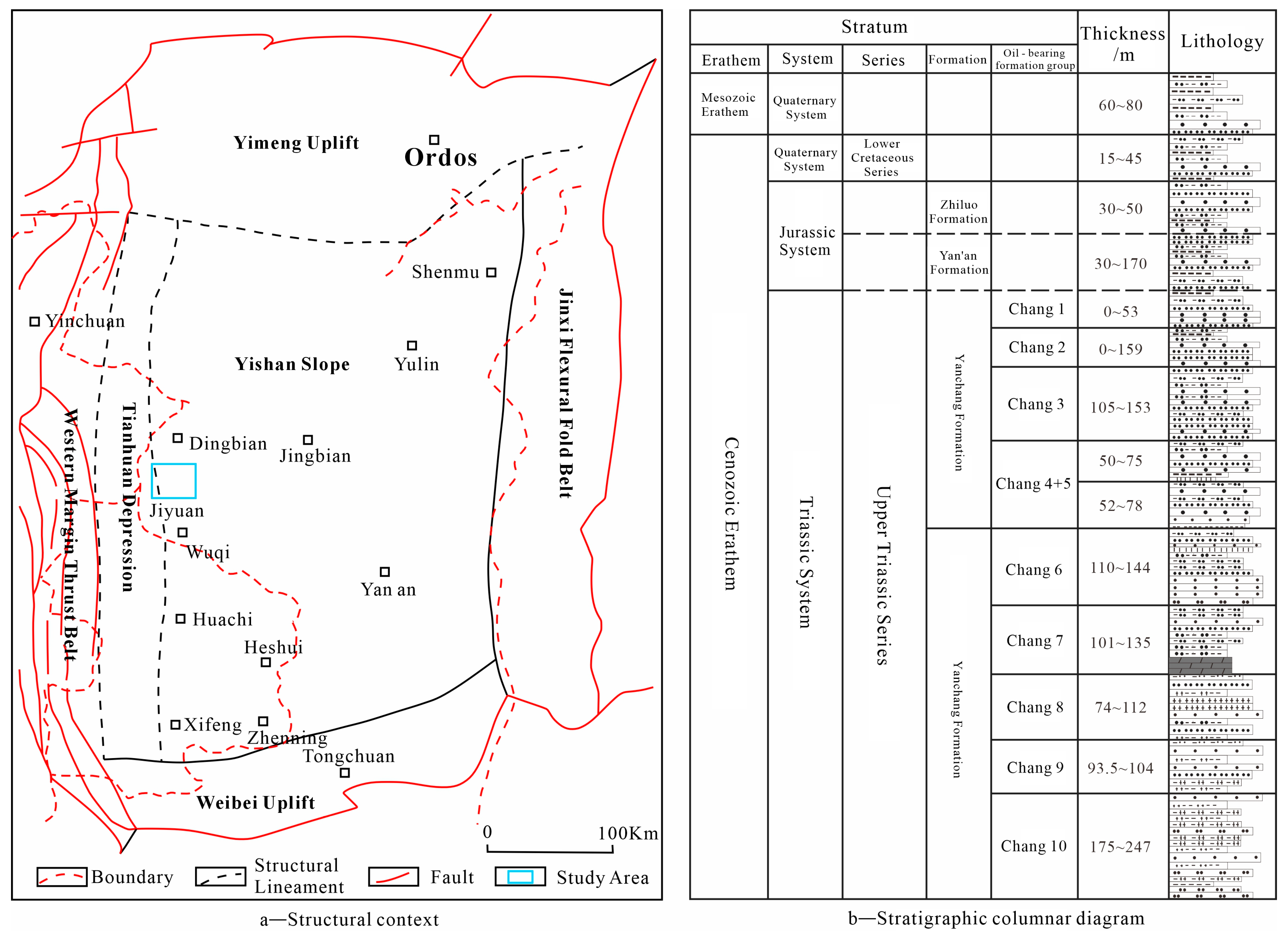
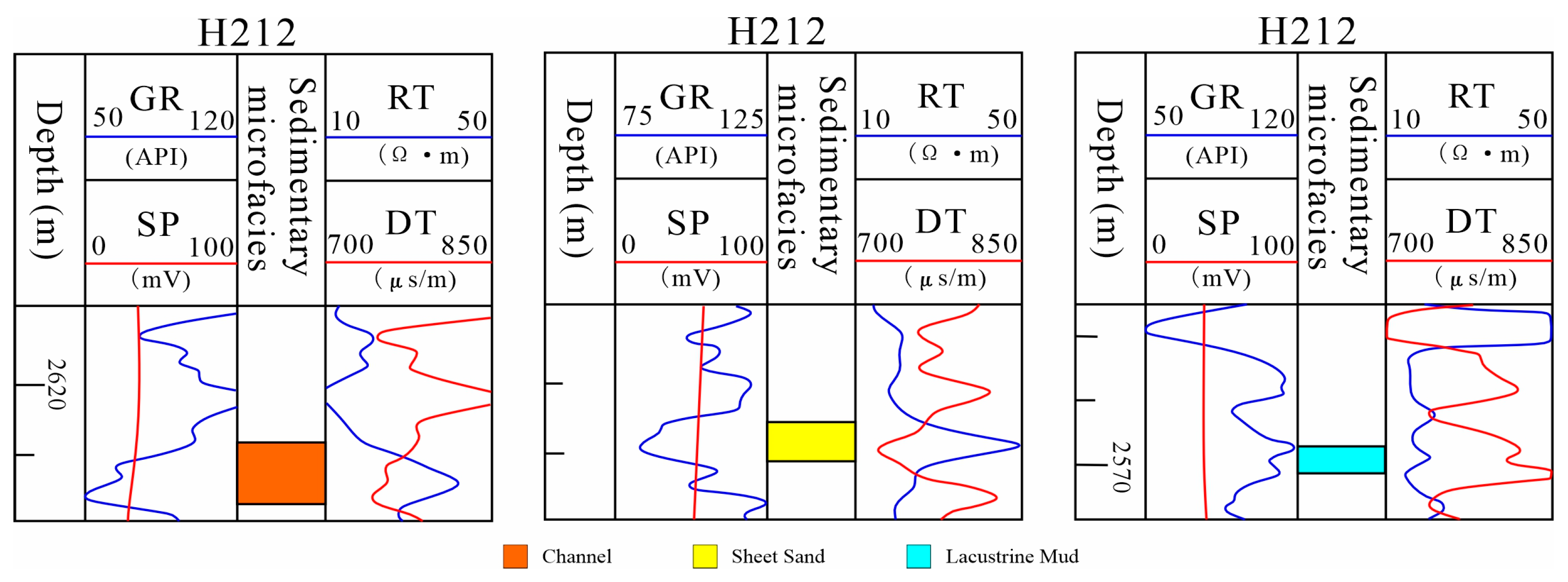
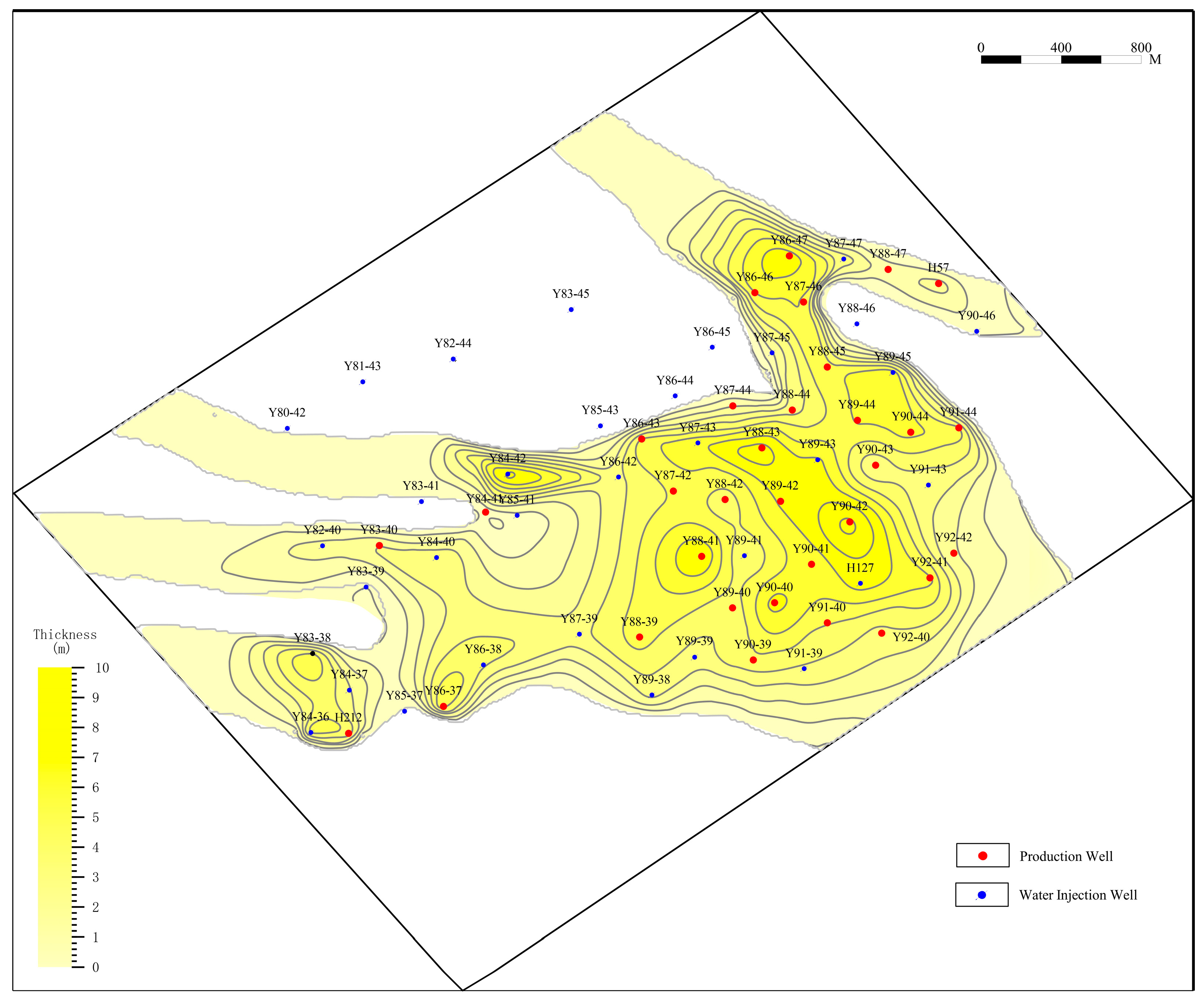






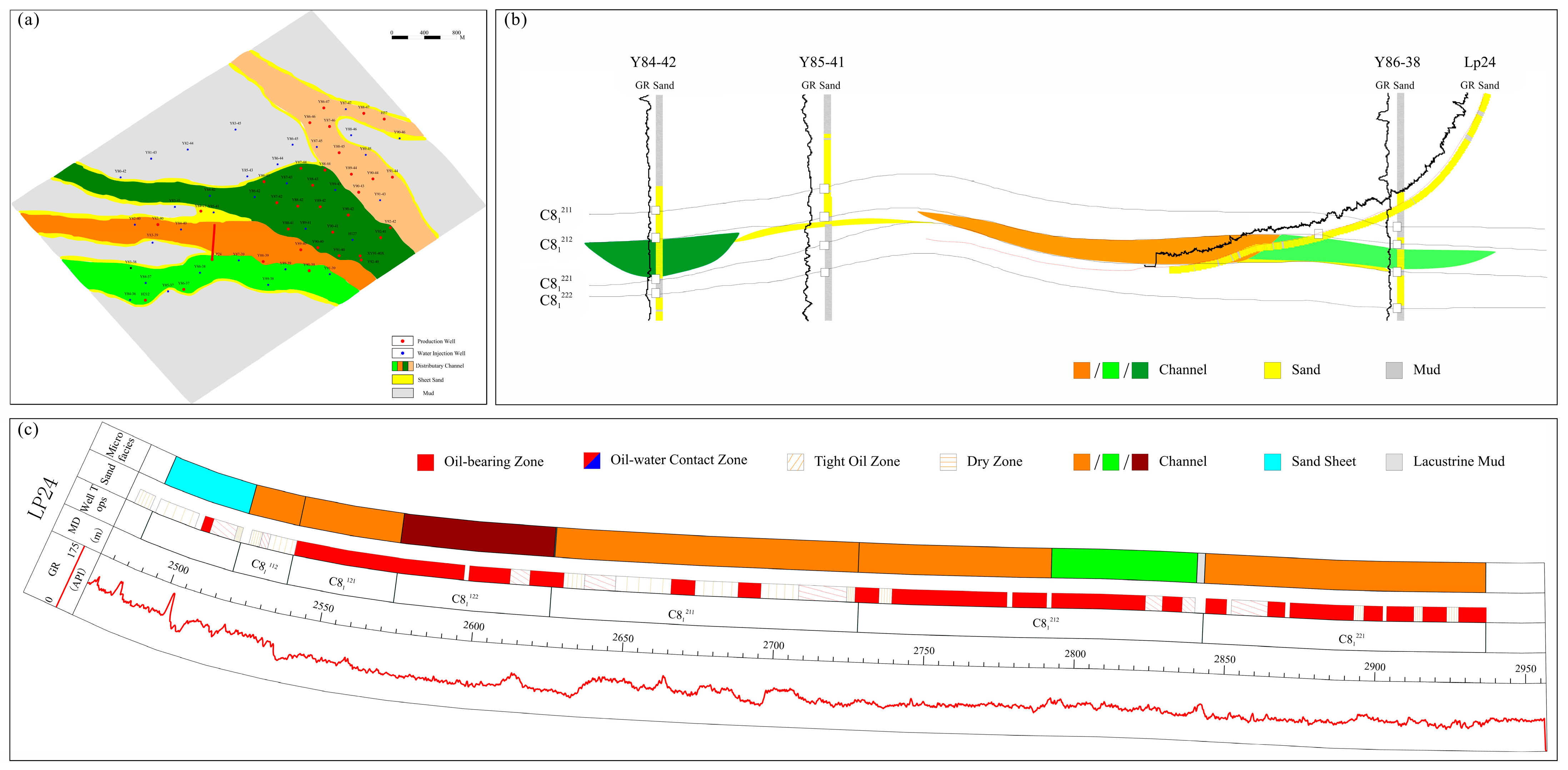



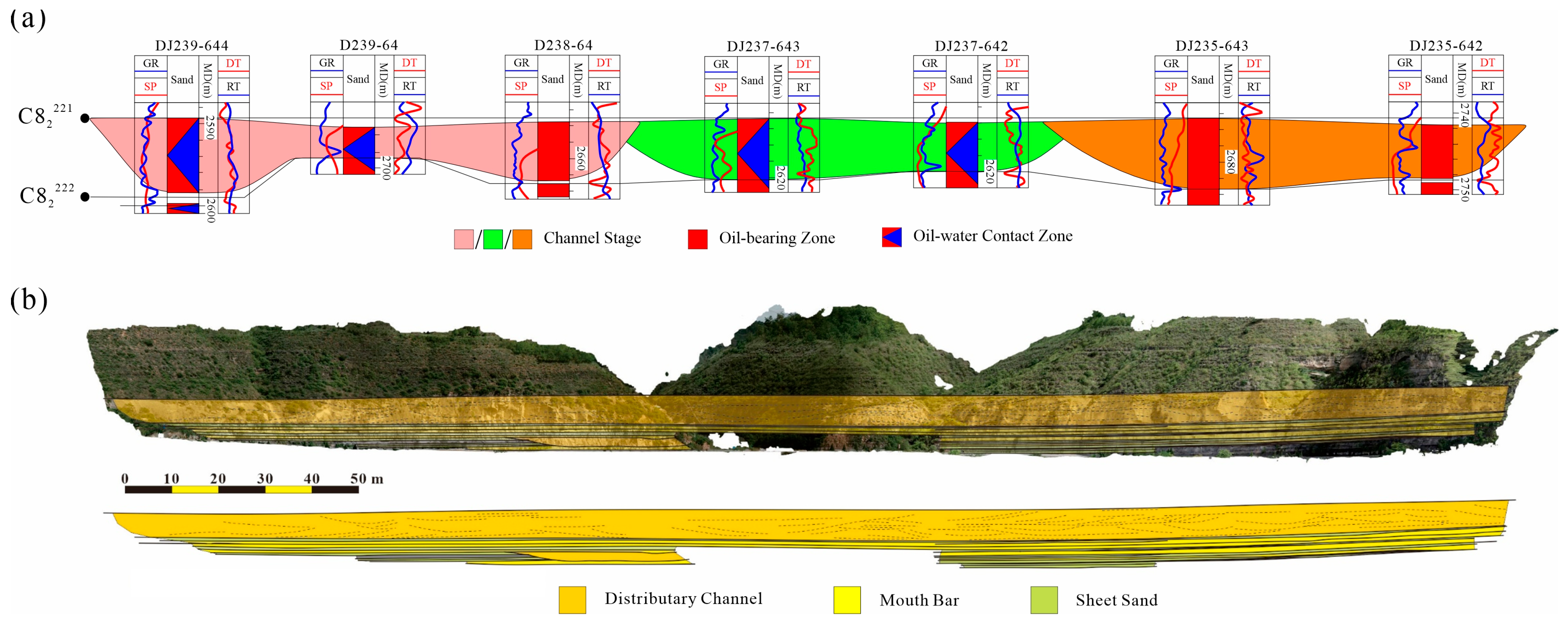

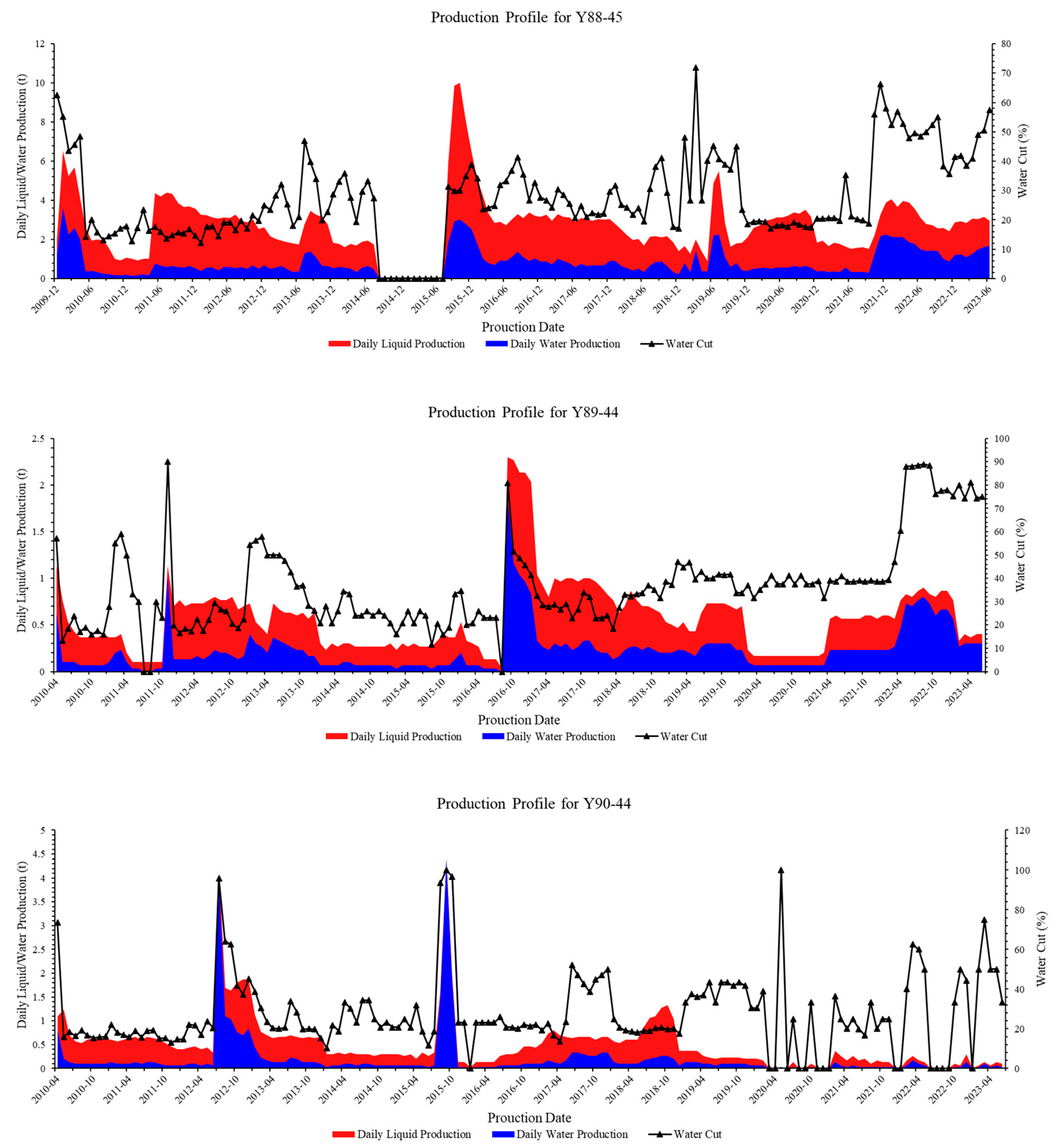
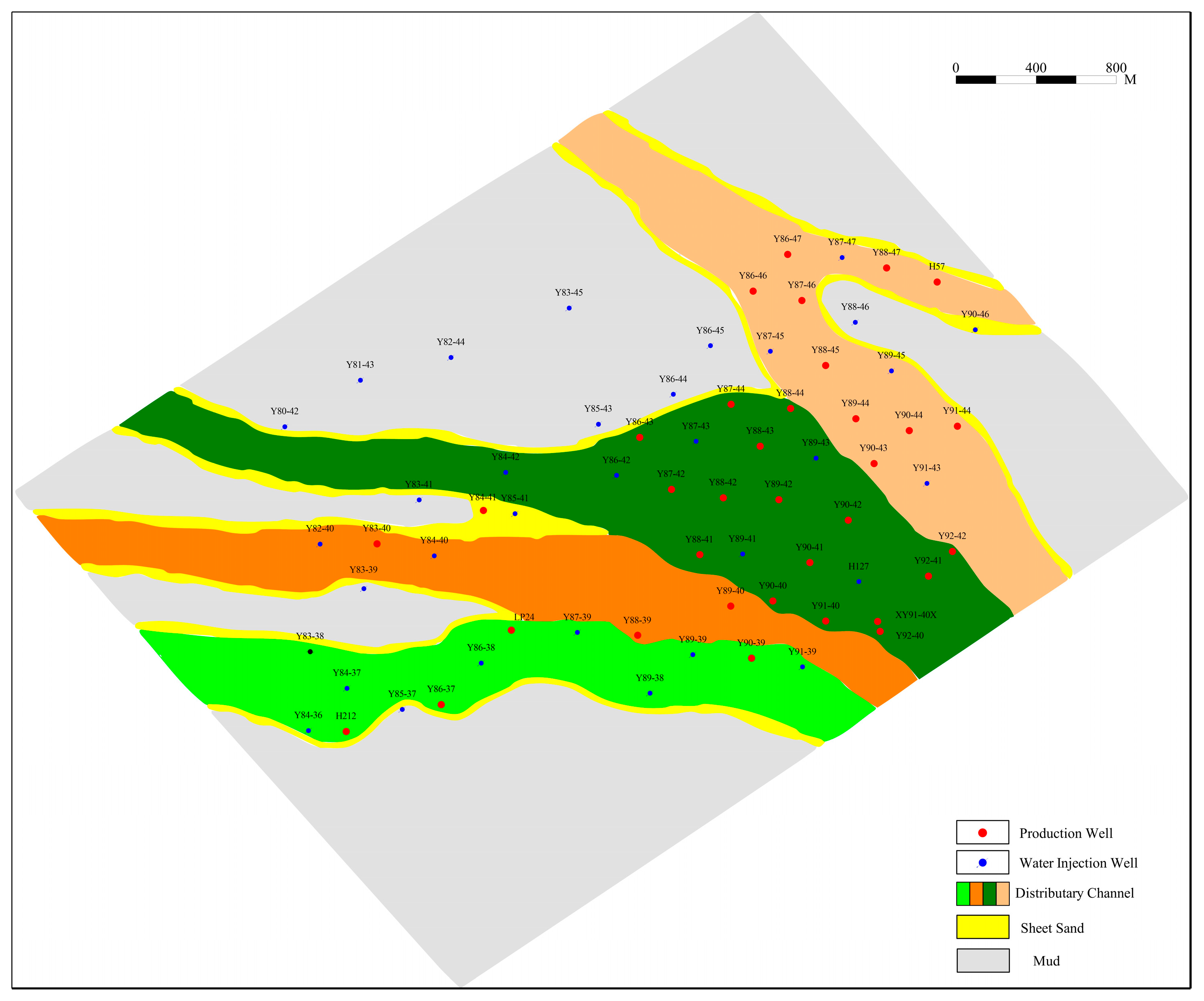
Disclaimer/Publisher’s Note: The statements, opinions and data contained in all publications are solely those of the individual author(s) and contributor(s) and not of MDPI and/or the editor(s). MDPI and/or the editor(s) disclaim responsibility for any injury to people or property resulting from any ideas, methods, instructions or products referred to in the content. |
© 2025 by the authors. Licensee MDPI, Basel, Switzerland. This article is an open access article distributed under the terms and conditions of the Creative Commons Attribution (CC BY) license (https://creativecommons.org/licenses/by/4.0/).
Share and Cite
Wang, L.; Yin, Y.; Wang, X.; Xie, P.; Hu, X.; Xiong, G. Architectural Anatomy and Application in an Ultra-Low-Permeability Reservoir: A Case Study from the Huang 57 Area, Jiyuan Oilfield. Appl. Sci. 2025, 15, 10828. https://doi.org/10.3390/app151910828
Wang L, Yin Y, Wang X, Xie P, Hu X, Xiong G. Architectural Anatomy and Application in an Ultra-Low-Permeability Reservoir: A Case Study from the Huang 57 Area, Jiyuan Oilfield. Applied Sciences. 2025; 15(19):10828. https://doi.org/10.3390/app151910828
Chicago/Turabian StyleWang, Lixin, Yanshu Yin, Xinyu Wang, Pengfei Xie, Xun Hu, and Ge Xiong. 2025. "Architectural Anatomy and Application in an Ultra-Low-Permeability Reservoir: A Case Study from the Huang 57 Area, Jiyuan Oilfield" Applied Sciences 15, no. 19: 10828. https://doi.org/10.3390/app151910828
APA StyleWang, L., Yin, Y., Wang, X., Xie, P., Hu, X., & Xiong, G. (2025). Architectural Anatomy and Application in an Ultra-Low-Permeability Reservoir: A Case Study from the Huang 57 Area, Jiyuan Oilfield. Applied Sciences, 15(19), 10828. https://doi.org/10.3390/app151910828





